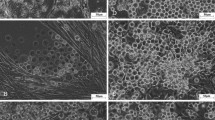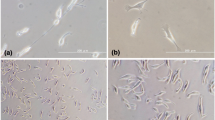Abstract
A new cell line named RIRI-PaDe, developed from the neonate larvae of Papilio demoleus Linnaeus, was established in modified Grace’s medium supplemented with 20% fetal bovine serum. The cell line was incubated at 28°C and consisted of attached round and short spindle-like cells. The population doubling time was 55 h. The chromosome numbers varied widely from 24 to 136 with a mode of 59 at the 71st passage. Comparison of mitochondrial cytochrome c oxidase subunit I gene of the cell line and neonate larvae confirmed that the cell line was of P. demoleus origin. This cell line was susceptible to the Autographa californica multicapsid nucleopolyhedrovirus and Apocheima cinerarius nucleopolyhedrovirus.





Similar content being viewed by others
References
Folmer O.; Black M.; Hoeh W.; Lutz R.; Vrijenhoek R. DNA primers for amplification of mitochondrial cytochrome c oxidase subunit I from diverse metazoan invertebrates. Mol. Mar. Biol. Biotech. 3(5): 294–299; 1994.
Granados R. R.; Li G.; Blissard G. W. Insect cell culture and biotechnology. Virol. Sin. 22(2): 83–93; 2007.
Grasela J. J.; McIntosh A. H.; Ringbauer J. J.; Goodman C. L.; Carpenter J. E.; Popham H. J. Development of cell lines from the cactophagous insect: Cactoblastis cactorum (Lepidoptera: Pyralidae) and their susceptibility to three baculoviruses. In Vitro Cell Dev. Biol. - Animal. 48(5): 293–300; 2012.
Ishikawa H.; Ikeda M.; Alves C. A.; Thiem S. M.; Kobayashi M. Host range factor 1 from Lymantria dispar nucleopolyhedrovirus (NPV) is an essential viral factor required for productive infection of NPVs in IPLB-Ld652Y cells derived from L. dispar. J. Virol. 78(22): 12703–12708; 2004.
Lewis D.S. Lime swallowtail, chequered swallowtail, citrus swallowtail Papilio demoleus Linnaeus (Insecta: Lipidoptera: Papilionidae). http://edis.ifas.ufl.edu/pdffiles/IN/IN78600.pdf. Cited 3 Sept. 2012.
Lynn D. E. Methods for maintaining insect cell cultures. J. Insect Sci. 2(1): 9–15; 2002.
Lynn D. E.; Shapiro M. New cell lines from Heliothis virescens: characterization and susceptibility to baculoviruses. J. Invertebr. Pathol. 72(3): 276–280; 1998.
Mitsuhashi J. Development of highly nutritive culture media. In Vitro Cell Dev. Biol. - Animal. 37(6): 330–337; 2001.
Mitsuhashi J. Invertebrate tissue culture methods. Springer, Tokyo, pp 307–400; 2002.
Murhammer D. W. Baculovirus and insect cell expression protocols, second edition. Humana Press Inc, Totowa, p 460; 2007.
Summers M. D.; Smith G. E. A manual of methods for baculovirus vectors and insect cell culture procedure. Tex. Agric. Exp. Station. (1555): 57; 1987.
Tamura K.; Dudley J.; Nei M.; Kumar S. MEGA4: molecular evolutionary genetics analysis (MEGA) software version 4.0. Mol. Biol. Evol. 24: 1596–1599; 2007.
Yeh S. C.; Lee S. T.; Wu C. Y.; Wang C. H. A cell line (NTU-MV) established from Maruca vitrata (Lepidoptera: Pyralidae): characterization, viral susceptibility, and polyhedra production. J. Invertebr. Pathol. 96(2): 138–146; 2007.
Zhang X.; Feng Y.; Ding W.; Chen X.; Wang C.; Ma T. Characterization of a new insect cell line that is derived from the neonate larvae of Papilio xuthus (Lepidoptera: Papilionidae) and its susceptibility to AcNPV. Tissue Cell 44(3): 137–142; 2012.
Zhang X.; Feng Y.; Ding W. F.; Chen X. M.; Wang C. Y.; Ma T. Establishment and characterization of an embryonic cell line from Gampsocleis gratiosa (Orthoptera: Tettigoniidae). In Vitro Cell Dev. Biol. - Animal. 47(4): 327–332; 2011.
Acknowledgments
This work was supported by grants from the National Ministry of Forestry of China (no. 2013-4-53) and Chinese Academy of Forestry (no. riricaf2012003M). We thank Dr. Ping Tang of the Jiangsu University for providing AcMNPV and Prof. Qilian Qin of the Institute of Zoology, Chinese Academy of Sciences, for providing AciNPV, HycuNPV, LdNPV, and AnpeNPV. We are grateful to Ms. Shanda Wheeler, in the Department of Entomology, Kansas State University, for reading the manuscript and giving suggestions on English grammar and writing.
Author information
Authors and Affiliations
Corresponding author
Rights and permissions
About this article
Cite this article
Ding, WF., Feng, Y., Zhang, X. et al. Establishment and characterization of a cell line developed from the neonate larvae of Papilio demoleus Linnaeus (Lepidoptera: Papilionidae). In Vitro Cell.Dev.Biol.-Animal 49, 108–113 (2013). https://doi.org/10.1007/s11626-012-9575-z
Received:
Accepted:
Published:
Issue Date:
DOI: https://doi.org/10.1007/s11626-012-9575-z




